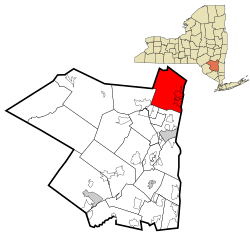Saugerties, NY
| Saugerties, New York | |
|---|---|
 Location in Ulster County and the state of New York. |
|
| Area | |
| • Total | 67.96 sq mi (176.02 km2) |
| • Land | 64.57 sq mi (167.25 km2) |
| • Water | 3.39 sq mi (8.77 km2) |
| Population (2010) | |
| • Total | 19,482 |
| • Estimate (2016) | 19,097 |
| • Density | 295.74/sq mi (114.18/km2) |
| FIPS code | 36-111-65299 |
Saugerties /ˈsɔːɡərtiz/ is a town in Ulster County, New York, United States. The population was 19,482 at the 2010 census. The Town of Saugerties contains the Village of Saugerties in the northeast corner of Ulster County. Part of the town is inside Catskill Park.
U.S. Route 9W and New York State Route 32 pass through the town, converging at the center of the village and overlapping to the south. These routes parallel the New York State Thruway (Interstate 87), which passes through the town just west of the village.
In the 1650s, Barent Cornelis Volge operated a sawmill on the Sawyer's Kill, supplying lumber for the manor of Rensselaerswick. He had secured a title from the Esopus Sachem to this lands sometime before 1663. Volge likely left the area at the outbreak of the first Esopus War in 1658. The "footpath to Albany" was not laid out until 1670. In April 1677 Governor Edmund Andros purchased land from the Esopus Indian Kaelcop, chief of the Amorgarickakan tribe for the price of a piece of cloth, a blanket, some coarse fiber, a loaf of bread, and a shirt. The Mynderse House was built by John Persen, formerly of Kingston, an early mill owner, around 1685.
In October 1710, 300 families who had immigrated to England from the Palatine region of Germany established camps on the east and west side of the Hudson. The camp on the west side of the river became known as West Camp in the Town of Saugerties. They were sent by the British government to manufacture naval stores for Her Majesty's fleet. The villages at West Camp were called Elizabethtown, Georgetown, and Newtown. Sawmills were established on the Esopus Creek. In 1998 a monument commemorating their arrival was erected on the lawn of St. Paul's Lutheran Church in West Camp.
...
Wikipedia
